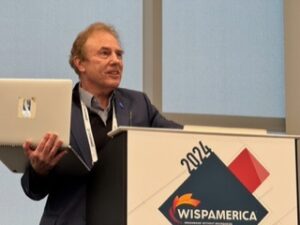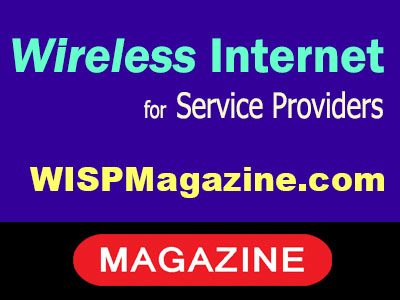By: Lawrence Harte
How 10 Hybrid Fiber Wireless Providers’ Stories – And Data, Research, and Analysis from The Carmel Group — Boost the Accelerated Growth of America’s Broadband Operators and Vendors
Introduction
WISPs need good business information to determine their strategic investments, effective operations plans, new revenue service options and targeted marketing campaigns. In North America’s rural areas, access to reliable broadband services is often limited by infrastructure challenges and geographic constraints. And by government policies. A recent WISPA[1] trade group-sponsored report, titled “The 2023-24 Headwinds Project,” delves into the remarkable stories of ten of the U.S.’ fixed wireless broadband service providers, operating in an extensively underserved rural nation. By harnessing industry research from The Carmel Group[2], each of the ten participants successfully acts to expand its customer base, increase revenues, and enhance profitability, especially catalyzing digital inclusion in nearly every one of their own often remote regions.
This “2023-24 Headwinds Project” was presented in the form of a 2024 WISPA America panel session involving three top FWA and Hybrid Fiber Wireless operators, on Wednesday, March 6, 2024 in OKC, from 8a-9a local time.
 Background
Background
Seven operators make up the core of this Q1 2024 policy-focused report. These are Aristotle Unified Communications, of Little Rock, AR; Brazos WiFi, of Bryan, TX; DC Access, of Washington, DC; MetaLINK Technologies, of Defiance, OH; ShastaBeam, of Redding, CA; VistaBeam, of Gering, NB; and WISPer Internet, of Mascoutah, IL. The three vendors who supply these seven, and many of the 2,700 other U.S. unlicensed fixed wireless and hybrid fiber wireless operators, are Aterlo of Waterloo, Canada, via its Preseem software; radio antenna manufacturer, RFelements, via its U.S. HQ in Dallas, TX; and broadband signal distributor, Tarana, with headquarters in Northern California’s Silicon Valley. A single top-level representative from each entity is highlighted to account for better storytelling and messaging.
All ten face formidable obstacles in delivering high-speed Internet access to rural residents. Some of the challenges include sparse population density, rugged terrain, and inadequate wired infrastructure. Recently, funding decisions at the federal level have been particularly problematic. Despite offering typically hyper-local involvement, speedy installation, extremely competitive pricing, and reliable service, these companies and their vendors still grapple constantly with new ways to achieve financial sustainability in each of their own challenging rural broadband marketplaces.
Challenges
Limited Market Insights: The “Headwinds” project is WISPA’s expert way of turning real-life successes, trials, and tribulations to help provide greater comprehensive insights into the unique needs and preferences of rural consumers, hindering these WISPA constituents’ ability to tailor their offerings and marketing strategies effectively. Having done several of these types of WISPA-sponsored report before, The Carmel Group was a logical selection to do a third report on behalf of the industry. The Carmel Group has researched and authored two prior WISPA industry studies, in 2016-17 the “Ready For Take-Off” Report See, https://www.wispa.org/media/v1/543/2024/01/2021_WISPA_Report_FINAL-compressed.pdf). and in 2020-21 the Lift-Off” Report (See, https://www.carmelgroup.com/2021-fixed-wireless-and-hybrid-fiber-wireless-report/). Both are free to access via those links.
Infrastructure Constraints: Building and maintaining broadband infrastructure in remote, sparsely populated areas poses significant logistical and financial challenges for all broadband operators.
Revenue Generation: With what is typically a small subscriber base (at best in the low thousands of subscribers), and with constrained growth prospects, these risk-taking rural broadband pioneers face difficulties in generating sufficient revenues to cover operational costs and to expand service footprints. That is especially the case following the action by the current White House, taken by way of its National Telecommunications and Information Agency (NTIA), an arm of the U.S. Department of Commerce. In that May 2022 mandate, the NTIA both excluded America’s unlicensed Fixed Wireless Access (FWA) providers from a $42+ billion funding base; while it concurrently delivered a monopoly of funds mostly to “fibered deep pockets,” with a sprinkling left over for a handful of wealthy licensed FWA licensees.
Solution
These ten vendor and operator representatives (the “Ten”), through their trade group, WISPA, recognized the need to augment their strategic capabilities. In a true word-of-mouth fashion, they have each and as a group leveraged industry research and insights from The Carmel Group, a trusted authority in the global telecommunications sector.
Implementation
The Carmel Group’s “Headwinds” project is planned for publication late in Q1 2024. It is expected to be available for free at both the WISPA website (See, www.wispa.org, “Industry Resources”; and The Carmel Group website, www.carmelgroup.com), this publication (See, www.wispmagazine.com), as well as via the websites of each of the ten involved vendors and operators, and elsewhere.
Market Understanding
The Carmel Group provided this grouping of ten with detailed market analysis, including demographic profiles, Internet usage patterns, and competitive landscape assessments, all specific to rural communities. Of late, policy challenges have been the foremost focus.
Insights into rural consumers’ connectivity needs and pain points empower these “Ten” to develop targeted marketing campaigns and tailored service offerings that resonate with each of their ten separate target audiences.
Infrastructure Optimization
The Carmel Group’s research highlights cost-effective infrastructure deployment strategies and innovative technologies suitable for rural broadband delivery. Each can now optimize their network architecture, as well as leverage fixed wireless technologies and strategic tower placements, to extend coverage to underserved areas, while minimizing capital expenditures. And while appropriately leveraging the appropriate governmental funding missions. The report also assists in the lobbying of regional, state, and federal governments, educating them to the importance of fair and competitive access for unlicensed FWA providers, especially during the next five-year period.
Revenue Diversification
By analyzing Carmel Group research on emerging trends and consumer demands, these “Ten” also identified opportunities to diversify revenue streams beyond basic broadband services. And to maximize existing network capabilities.
In another important example, in the future, each company will be better able to introduce value-added services. These ancillary offerings will include more digital voice, home automation, telemedicine, Internet of Things (IoT), and online education platforms tailored to the needs of rural customers, unlocking new revenue opportunities and enhancing customer satisfaction.
Revenue Expansion
Diversification of revenue streams and introduction of value-added services significantly augments nearly every operator’s and vendor’s top-line revenue, reducing their reliance on basic broadband subscription fees.
Bundled service packages and strategic partnerships with local businesses further bolster revenue generation, fostering long-term financial sustainability for each.
Subscriber Growth
Informed by Carmel Group insights, each is now able to implement targeted marketing initiatives, including community outreach programs, resulting in a notable increase in subscriber acquisitions. Or resulting in enhanced revenues sourced from better satisfied subscribers. Or, equally important, “leveling the playing field” vis-à-vis future funding awards, and making sure future governmental funding is based more on the “right tool for the job” than it is on political successes.
Tailored service offerings and improved network reliability enhance WISPA’s and its members’ reputation and credibility, driving organic word-of-mouth referrals and accelerating subscriber growth deeper into their many thousands of mostly-rural communities.=
Profitability Enhancement
For any for-profit business, an important bottom line has to be profits. Through efficient network optimization and streamlined operations, guided by The Carmel Group’s research and analysis, these entities sooner achieve improved cost-efficiency and profitability.
Enhanced economies of scale, coupled with prudent resource allocation, propel each of these “Ten” to further financial viability, and long-term growth in the rural broadband market segment.
Results
Two sought-after results emerged. First, is to better educate both industry and governments, the latter of every type and persuasion, including federal, state, regional and local. As well as federal and state Executive, Legislative, and Judicial entities. Second, especially at the operator and vendor levels of WISPA, the trade association has better assisted and served its rather passionate membership.
Conclusion
By leveraging industry research, deeply seasoned and expert analysis, and strategic insights from The Carmel Group, WISPA citizens and American Broadband citizens are better able to counter formidable challenges and to catalyze digital inclusion in rural communities. The synergistic partnership between WISPA, its members, and The Carmel Group enables the entire collective industry to expand its subscriber base, increase revenues, and enhance profitability, while bridging the persistent “Digital Divide” in underserved regions. As a beacon of every kind of rural connectivity,[3] WISPA exemplifies the transformative impact of informed decision-making and strategic foresight in advancing broadband access and empowering rural communities.
This set of Ten Case Studies underscores the transformative power of industry research and strategic partnerships, in driving growth and sustainability for FWA and hybrid fiber wireless broadband providers, operating in mostly-rural areas like Aristotle Unified Communications, Brazos WiFi, DC Access, MetaLINK, ShastaBeam, VIstaBeam, and WISPer Internet.
Bonus Prize: The generous donor of graphics for the “2023-24 Headwinds Project,” vendor RFelements, has additionally contributed a special Podcast, describing the five-month chore. That video can be accessed, for free, at this link: https://www.youtube.com/watch?v=f84BIu80VNc. It is worth a quick and easy look.
References:
[1] WISPA is the Wireless Internet Service Providers Association, located in Washington, DC (See, www.wispa.org).[2] The Carmel Group’s website link is www.carmelgroup.com.
[3] Importantly for its future success and that of its members, WISPA’s tagline in “Broadband Without Boundaries.”

